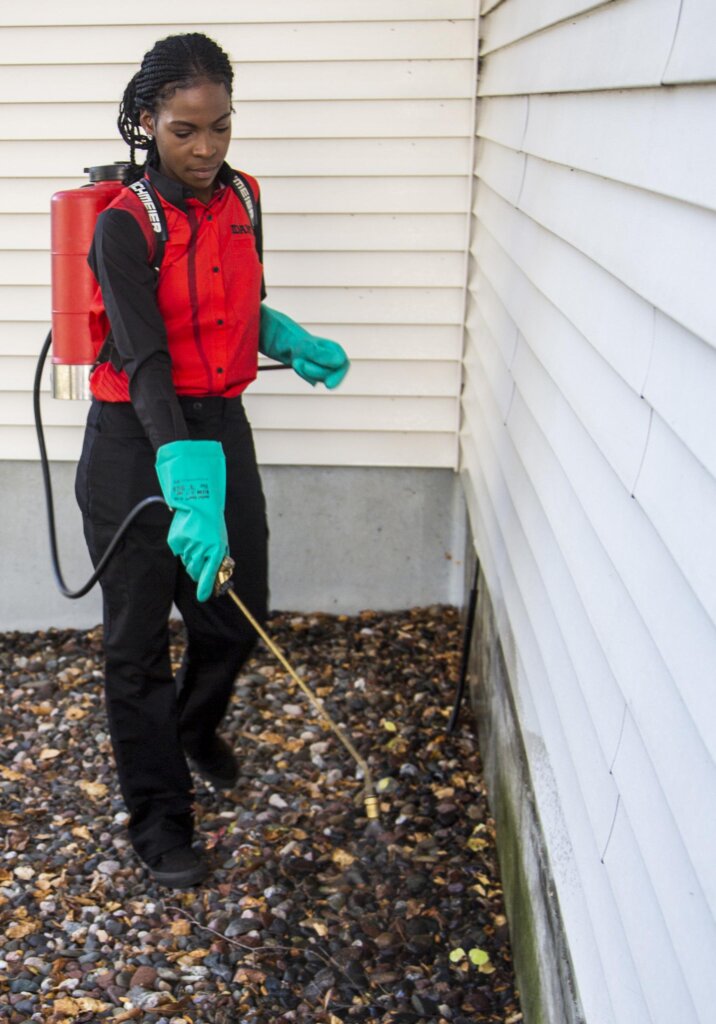Quality A1 Pest Control Services Charlotte - Safeguard Your Home
Quality A1 Pest Control Services Charlotte - Safeguard Your Home
Blog Article
Bed Pest Treatment Malfunction: Contrasting Chemical Vs. Non-Chemical Solutions
In the world of bug control, especially when dealing with the relentless problem of bed bugs, the selection between chemical and non-chemical therapy options can be a critical one. Both strategies offer distinct advantages and downsides, influencing variables such as efficiency, safety factors to consider, and total cost. By taking a look at the nuanced information of each technique, a clearer understanding of which course to pursue in attending to a bed bug invasion can be attained.
Effectiveness of Chemical Therapies
Chemical therapies for bed pest infestations have actually been commonly acknowledged for their fast and potent efficiency in removing these insects. When considering the effectiveness of chemical therapies, it is vital to comprehend that they can supply a detailed and quick option to a bed insect trouble. Specialist pest control specialists usually depend on pesticides to target bed pests at different phases of their life process, including adults, fairies, and eggs. These chemicals usually work by interrupting the bed insects' nerves, bring about paralysis and ultimate fatality.
Moreover, chemical therapies have the benefit of offering recurring results, indicating that they can remain to get rid of bed bugs also after the initial application. This recurring action is specifically beneficial in combating any possible re-infestations. Furthermore, the rapid action of chemical therapies can bring relief to people dealing with serious bed insect invasions, allowing them to gain back control of their living areas rapidly.
Safety And Security Worry About Chemical Solutions
One crucial aspect that requires careful consideration when making use of chemical services for bed bug therapy is ensuring the safety and security of passengers and the environment. While chemical treatments can be reliable in eradicating bed pests, they may posture threats if not managed appropriately. Among the key safety worry about chemical services is the potential injury they can create to human wellness. Direct exposure to particular chemicals used in bed bug therapies can result in respiratory concerns, skin irritability, or other negative reactions, particularly in people with pre-existing problems or level of sensitivities. In addition, incorrect application or dose of chemical pesticides can lead to hazardous deposits sticking around in the treated location, posing long-term health and wellness threats to passengers.
Moreover, the ecological influence of chemical services is one more substantial consideration. Some pesticides made use of in bed insect therapies might be hazardous to advantageous insects, wild animals, and environments if they seep right into the soil or water supply. It is important to make use of chemical therapies judiciously, complying with safety and security guidelines, and taking into consideration less harmful alternatives to mitigate these risks and ensure the safe and efficient administration of bed insect problems.
Benefits of Non-Chemical Methods
Thinking about the potential safety problems and ecological effect associated with chemical remedies for bed insect therapy, exploring non-chemical strategies provides a promising option with several distinctive advantages. Non-chemical therapies are eco pleasant, as they do not contribute to air or water pollution, making them a sustainable option for parasite control.
Additionally, non-chemical services can be efficient in targeting bed bugs, including hard-to-reach locations where chemical treatments may not pass through. Approaches such as warm therapy, vacuuming, steam cleaning, and bed mattress encasements offer thorough eradication without making use of unsafe chemicals. In addition, non-chemical methods can be much less disruptive, requiring marginal preparation and enabling quicker reentry right into dealt with locations. In general, what's the best termite treatment choosing non-chemical bed pest therapy methods not only prioritizes safety and security and ecological security yet likewise guarantees efficient and detailed pest control.
Limitations of Non-Chemical Treatments

In addition, non-chemical therapies often call for multiple applications to attain successful eradication. This can be taxing and might not constantly guarantee full elimination of all bed bugs and their eggs, particularly in surprise or hard-to-reach locations.
In addition, the success of non-chemical therapies heavily relies on proper implementation and thoroughness, which can be testing for people without expert expertise. Poor application of non-chemical techniques may cause incomplete eradication, resulting in consistent problems and the need for additional treatments.
Therefore, while non-chemical treatments have their advantages, it is vital to acknowledge these limitations and consider them when determining one of the most effective approach for handling bed bug infestations.
Price Contrast: Chemical Vs. Non-Chemical Options
Offered the limitations connected with non-chemical therapies, an important aspect to evaluate in the context of bed insect administration is the price contrast in between chemical and non-chemical alternatives. In comparison, non-chemical treatments like warm therapy or steam can be a lot more expensive, with costs ranging from $1,000 to $6,000 for a whole home. While the preliminary cost of chemical treatments may seem lower, numerous treatments might be called for to totally eliminate the infestation, possibly boosting the overall expense.
Conclusion

Thinking about the potential safety worries and ecological influence associated with chemical solutions for bed pest treatment, exploring non-chemical techniques provides an encouraging alternative with numerous unique advantages.Given the restrictions linked with non-chemical treatments, a vital element to evaluate in the context of bed bug monitoring is the cost comparison between chemical and non-chemical click for info choices. In comparison, non-chemical therapies like heat therapy or vapor can be much more costly, with costs ranging from $1,000 to $6,000 for an entire home. While the preliminary cost of chemical treatments might appear lower, multiple treatments might be needed to completely eliminate the problem, possibly boosting the overall expense.In final thought, Read More Here when comparing chemical and non-chemical bed bug therapy alternatives, it is essential to take into consideration efficiency, safety, benefits, constraints, and cost.
Report this page